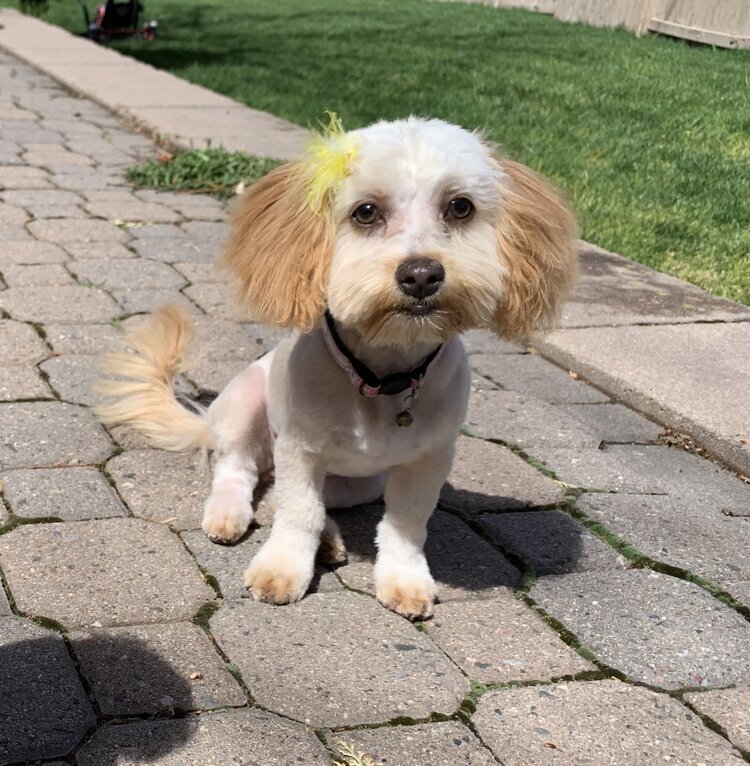Maltipoo Eye Infections & More
Maltipoo Eye Infections
Maltipoo eye infections are not uncommon. The eyes can be very vulnerable to debris and germs. Most eye infections are due to bacteria that enter from around the eye area. The less common infections are caused from viruses, trauma and allergy issues. However, in those cases the infection is an issue that is secondary.
With tight budgets many owners will try home remedies, but seeing a vet is always encouraged. There may be a small tear that you cannot see and many eye infections must be treated with antibacterial drops - which is something that owners usually do not have access to in the house.
Signs of a Maltipoo Eye Infection
Persistent redness
Excessive tearing
Pawing at the eye(s)
Excessive discharge
Crusting
Excessive blinking
Sensitivity to light
The Most Common Eye Infections are:
Conjunctivitis (pink eye) - This can be bacterial or viral. Causes can include Lyme disease, injury to the tear sac, debris.
Glaucoma – Can lead to blindness if not treated. Signs include cloudiness, enlarged pupils, redness. It is vital to have your vet treat this promptly to avoid blindness.
Keratoconjunctivitis Siccac (dry eye) - tear ducts become blocked and/or infected. Without treatment can progress into eye ulcers and/or cornea damage. Dogs should be treated with eye drops (artificial tears) and sometimes with other medications such as anti-inflammatory and/or anti-bacterial.
Juvenile Cellulitis - Happens to dogs under the age of 2. Most common and obvious sign are blisters around the eyes, that can turn into ulcers.
If your Maltipoo shows any signs of infection, a checkup should be scheduled as soon as possible. Many infections and diseases respond best if caught early.
Maltipoo Bloodshot Eyes
When your Maltipoo has bloodshot eyes, superficial blood vessels within the surface of the affected eye will enlarge and dilate, causing the eye to appear red.
This can be caused by irritation. The most common irritation is a small piece of debris in your maltipoo’s eyes. If a Maltipoo is outside, a tiny piece of dirt or or fox tail can get stuck in the eye. When inside, even a tiny food particle may be the cause.
With acute cases happening rarely, flushing the eye with clean water can help clear out the irritant. This can be done with a small disposable cup. Having a helper will make things easier as well.
Allergies can be another reason that your Maltipoo may have red eyes. In most cases, this will be an ongoing issue (seasonally or year round).
Maltipoo Eye Discharge
While some irritation may be overlooked, if bloodshot eyes are seen along with discharge coming from a Maltipoo's eyes, it can be a sign of an eye disorder, infection, or other issue that will need immediate attention.
Clear discharge can be signs of allergy or debris.
Yellow, green, puss-like, thick and/or discharge that crusts along the eyelash are all signs of infection and should be discussed with your veterinarian. While most cases can be easily treated with eye drops and antibacterial solution, excessive discharge can also be a symptom of severe eye issues that can lead to blindness. For this reason, prompt veterinarian attention should be received.
Maltipoo Eye Boogers
While many owners refer to build up in the corners of a Maltipoo's eyes as eye boogers, this is also referred to as 'eye goop'.
If the eye goop is green or has a foul odor, this is a sign of infection. However, it can be common for dogs to have a natural secretion that can collect in the corners of the eyes.
Most owners will see this in the morning when their Maltipoo wakes up. All throughout the day, our puppies and dogs are blinking. That blinking helps removes dust, debris, and super fine particles from the eye. The eye will stay lubricated while your Maltipoo is blinking.
Overnight, when a dog isn’t blinking, or on days when there are extra irritants (high pollen days, etc.), blinking may not be enough and the discharge can build up.
As long as there is no reason to suspect an eye infection, routine cleaning will take care of these Maltipoo eye boogers.
